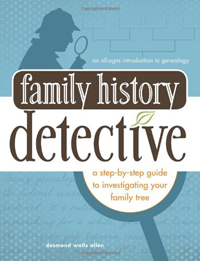 There are many beginner genealogy books, and guides, and workbooks, and reference sheets, etc. Many are well written, some personable, and others just plain fun. No one book is best and no one author is better or more knowledgeable than the rest. So, when yet another newbie’s guidebook comes across my desk I don’t just assume it has nothing more to offer than the last one. For that matter, it is ok to own and reference more than one book. There may be some crossover, but there is always something new to learn, a new perspective from which to view your research. Thus, I review a book with its own beginner’s twist to researching your family history, the Family History Detective: A Step-by-Step Guide to Investigating Your Family Tree, by Desmond Walls Allen.
There are many beginner genealogy books, and guides, and workbooks, and reference sheets, etc. Many are well written, some personable, and others just plain fun. No one book is best and no one author is better or more knowledgeable than the rest. So, when yet another newbie’s guidebook comes across my desk I don’t just assume it has nothing more to offer than the last one. For that matter, it is ok to own and reference more than one book. There may be some crossover, but there is always something new to learn, a new perspective from which to view your research. Thus, I review a book with its own beginner’s twist to researching your family history, the Family History Detective: A Step-by-Step Guide to Investigating Your Family Tree, by Desmond Walls Allen.
Usually, when I read the words step-by-step, I think of a how to book that literally walks the reader through a process, like filling out a family group sheet, step-by-step. Not so with this book. In these pages steps are more like topic areas. Some should be covered and practice before others, but not all must come in the order presented. Instead, the researcher should read this book to understand each of these key areas in order to become an overall better genealogist.
The book was written for all age groups to easily understand, making genealogy fun and exciting. According to the cover, you will find inside the book:
- Tips on how to find family history information in scrapbooks, journals, photo albums and other sources in your own home
- Websites, resources and techniques for online research
- How to locate and effectively use census, courthouse, and church records
- An overview of library and archive research
- Instructions on how to plan, record, and organize your research
I personally like the fact the book starts with what I consider to be the two most important elements to successful research. First, to think like an investigator, or as the author calls it, “Playing Sherlock Holmes.” The other key step is to start with yourself. This means both looking for what evidence you have in your possession or can identify in your own characteristics as well as collecting your own documents and stories to leave behind for future generations.
Each step, or chapter, offers up a selection of examples and ends with a boxed listing of “Key Clues” which nicely summarize each step.
Table of Contents
Introduction
Step 1 – Where’s You Get Those Eyes?: The Why, What, and How of Family History
Step 2 – Playing Sherlock Holmes: The Genealogist’s Skills and Goals
Step 3 – Beginning at the Beginning: Your Family History Starts With You
Step 4 – Raiding the Refrigerator: Searching Home Sources for Information
Step 5 – A Place for Everything: Keeping Records
Step 6 – Branching Out: Beginning Research Online and in Libraries and Archives
Step 7 – You Can’t Have One Without the Other: History and Genealogy
Step 8 – Taking Names: Finding Census Records
Step 9 – Your Days in Court: Research at the Courthouse
Step 10 – Putting it All Together: Sharing Your Family History
Appendix A: Guide for Sources Citations
Appendix B: Resources
Appendix C: Forms
Index
You can get a copy of Family History Detective: A Step-by-Step Guide to Investigating Your Family Tree from Family Roots Publishing; Price $16.65.